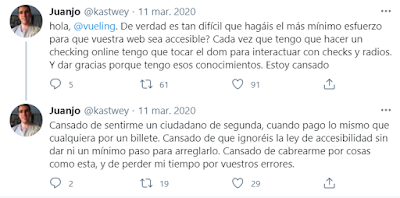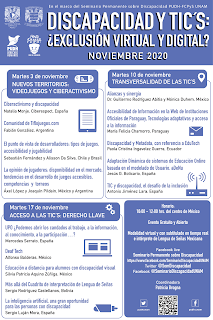En la noticia Derechos Sociales multa a Vueling con 90.000 euros por mantener una web poco accesible a personas con discapacidad podemos leer:
El Ministerio de Derechos Sociales y Agenda 2030 ha multado con 90.000 euros a la aerolínea Vueling (filial de IAG) por mantener una web inaccesible a las personas con ciertas discapacidades. La resolución, firmada por el secretario de Estado, Nacho Álvarez, constata que la empresa española incumple 26 de los 38 indicadores que exige la ley. Y determina una sanción por una infracción "grave en su grado máximo" ya que la compañía ya fue objeto de una inspección, y posterior sanción, en 2015.
Desde entonces, señala el documento, "no ha trabajado en la mejora de la accesibilidad de su página web". "La situación de la accesibilidad de la web de VUELING apenas ha mejorado: de los 38 requisitos establecidos (...) en 2015 se incumplían 27, 17 de ellos en más del 90% de las páginas, frente a los 26 que se incumplen en 2018, 15 de ellos en más del 90% de las páginas. Por lo que respecta a los incumplimientos de criterios del nivel A, han pasado de 13 en 2015 a 11 en 2018", apunta la resolución.
[...]
El expediente sancionador, a cuya resolución ha tenido acceso elDiario.es, arrancó en 2018 después de que un usuario denunciara a Vueling "por incumplimiento de las condiciones de accesibilidad para personas con discapacidad". En septiembre de ese año se inicia formalmente el proceso y se encarga un informe al Centro Nacional de Tecnologías de la Accesibilidad (CENTAC) que analice la denuncia y las diferencias con 2015, año en el que otra inspección ya detectó graves incumplimientos.
El informe del CENTAC (una fundación público-privada), realizado entre el 22 de octubre y 9 de noviembre de 2018, señala que "de los 38 requisitos que es preciso cumplir según la norma UNE 1390803:2012, se cumplen totalmente 4, es decir el 10,5%. Tenemos 26 requisitos, el 68,4%, que no se cumplen. Además, 8 requisitos, el 21,05%, no son aplicables". De esos 16, continúa el informe, "un poco más de la mitad de los errores se producen en casi todas las páginas, lo que puede indicar un problema sistemático de aplicación de los criterios de accesibilidad. 15 "aparecen con mucha frecuencia" y 11 de ellos "se concentran en el nivel A" de prioridad, es decir, los más sensibles. Los puntos del nivel A "son obligatorios ya que cualquier sitio que no cumpla los puntos recogidos en estas prioridades no se puede considerar razonablemente accesible", recuerda el informe.
Pero el CENTAC compara además la situación de 2018 con la de 2015, cuando otra denuncia activó una inspección similar. Y la conclusión a la que llega es que Vueling no hizo prácticamente nada para mejorar el cumplimiento de la normativa vigente. Esto hizo que la resolución concluyera con esta la sanción.
Los problemas de Vueling no son nuevos, en Twitter podemos encontrar quejas de algunos usuarios, como por ejemplo:
hola, @vueling. De verdad es tan difícil que hagáis el más mínimo esfuerzo para que vuestra web sea accesible? Cada vez que tengo que hacer un checking online tengo que tocar el dom para interactuar con checks y radios. Y dar gracias porque tengo esos conocimientos. Estoy cansado
— Juanjo (@kastwey) March 11, 2020
Cansado de sentirme un ciudadano de segunda, cuando pago lo mismo que cualquiera por un billete. Cansado de que ignoréis la ley de accesibilidad sin dar ni un mínimo paso para arreglarlo. Cansado de cabrearme por cosas como esta, y de perder mi tiempo por vuestros errores.
— Juanjo (@kastwey) March 11, 2020
Por cierto, Vueling ha publicado lo siguiente en Twitter respecto a la noticia publicada:
Del total de los indicadores requeridos, alrededor del 50% están a día de hoy ya implementados. Para la aplicación del resto, la compañía tiene ya establecida una línea de trabajo. 1/2
— Vueling Airlines (@vueling) February 7, 2021
Lamentablemente, la situación actual, provocada por la pandemia del Covid19, ha obligado a que esa implementación sea más lenta de lo que esperábamos. En cualquier caso, queremos lamentar los inconvenientes que esta situación pueda generar a nuestros clientes. 2/2
— Vueling Airlines (@vueling) February 7, 2021
En Expediente sancionador contra Vueling explico el primer expediente sancionador que recibió Vueling.
Por cierto, Vueling también recibió hace un par de años una sanción de la Agencia Española de Protección de Datos: La AEPD ha impuesto a Vueling una multa de 30.000 euros por incumplir la normativa en materia de cookies.




